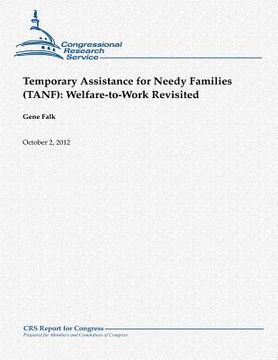Temporary Assistance for Needy Families (TANF): Welfare-to-Work Revisited (in English)
Synopsis "Temporary Assistance for Needy Families (TANF): Welfare-to-Work Revisited (in English)"
One of the central features of the Temporary Assistance for Needy Families (TANF) block grant is promoting work and job preparation for parents (mostly single mothers) in families that receive cash assistance. TANF was created in the 1996 welfare law, which was the culmination of a decades-long evolution from providing single mothers "pensions" to permit them to stay home and raise children to a program focused on work. State TANF programs were influenced by research conducted during a period of much experimentation on welfare-to-work initiatives in the 1980s and early 1990s, which found that mandatory work requirements could reduce welfare receipt and increase employment among single mothers. TANF aids some of the most disadvantaged families with children. These families are in a wide range of circumstances, and some of them are not subject to state welfare-to-work efforts. In FY2009, about 6 in 10 TANF assistance families had "work-eligible" individuals. TANF work eligible individuals comprise in great part single mothers with young children. In FY2009, about a third of TANF work-eligible mothers were young (under the age of 24). Additionally, 43% of all work-eligible women lacked a high school diploma or the equivalent. As a block grant to the states, TANF sets federal goals such as ending dependence of needy parents on government through work and job preparation, gives states flexibility in program design to achieve those goals, and measures the performance of states. The work requirements that actually apply to recipients are determined by the states, not by federal rules. In FY2009, a monthly average of 42% of all work-eligible adults were either working or engaged in a job preparation activity. The most common activity was working in a job while remaining on the rolls. This was followed in turn by job search and vocational educational training as the second and third most common activities. While state rules-not federal rules-determine work requirements for individual TANF recipients, federal TANF law establishes work participation standards that apply to the states and influence state program designs. The federal work standards are performance measures used to assess state TANF welfare-to-work efforts. The federal TANF work standards set target participation rates, specify activities that can be counted toward meeting the standards, and set minimum hours of engagement per week in a month for a recipient to be considered engaged in countable activities. The target participation rates vary by state: the statute sets a 50% standard for all families, but the standard is reduced by credits states may earn for caseload reduction. In FY2009, the official TANF work participation rate was 29.4%; however, all but eight states met their work standard. The TANF work standards date back to the 1996 law, and reflect the policy concerns and the research on welfare-to-work programs of the time. Research on new welfare-to-work models since the 1996 law have yielded mixed and very limited results. However, some innovations in workforce and education programs have yet to be tested within a welfare-to-work context. Policymakers also face questions about whether the sole focus of the assessment of TANF's success ought to be welfare-to-work. TANF has evolved into a program where cash assistance represents less than 30% of its funds. Policymakers thus face questions of whether consideration might be given to developing measures and assessment of how well TANF does in meeting other goals related to improving the circumstances of families with children.

